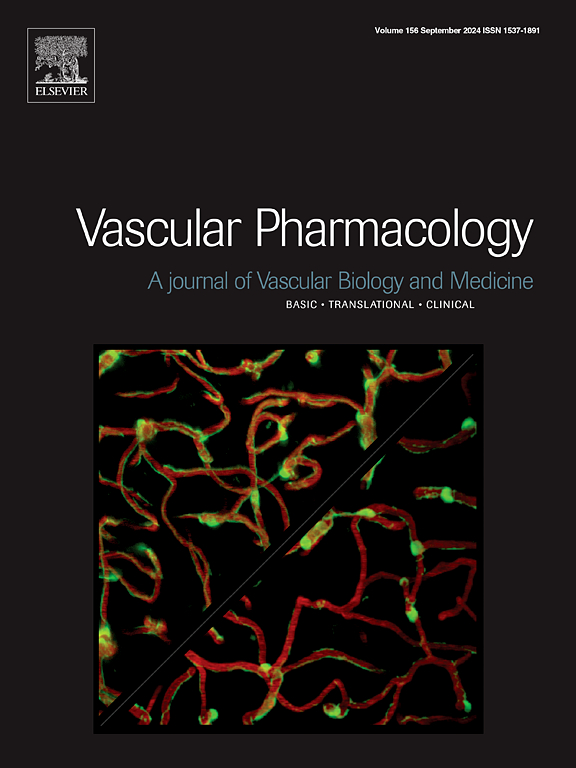IL-1β inhibition in stabilizing atherosclerotic plaques: The critical role of fibroblast-like cells
IF 3.5
3区 医学
Q2 PHARMACOLOGY & PHARMACY
引用次数: 0
Abstract
Targeting interleukin-1 beta (IL-1β) to mitigate inflammation is known to stabilize atherosclerotic plaques, thereby lowering the risk of acute cardiovascular events. The precise mechanisms are not yet known.
Fideler et al. examined the effects of IL-1β on exaggerated atherosclerosis following clonal hematopoiesis of indeterminate potential (CHIP). Unexpectedly, they showed an effect of IL-1β blockage on fibroblast-like cells and their role in the progression of atherosclerosis in the presence of CHIP. Here, we discuss these findings and place them in context of current insights on plaque fibroblast identity and function. While single cell sequencing studies had observed the presence of plaque fibroblasts in atherosclerotic plaques, their function has yet to be unraveled. By focusing on both in vitro and ex vivo models, the research explored how IL-1β stimulation drives functional and molecular changes in fibroblast-like cells, such as increased cytokine production and enhanced matrix degradation, which replicate the inflammatory microenvironment commonly seen in atherosclerotic lesions. Furthermore, the study suggests that inhibiting IL-1β might encourage the accumulation of fibroblast-like cells within the fibrous cap, a process that could improve plaque stability by reducing inflammatory activity and strengthening the structural integrity of the plaque. Depletion of proteoglycan 4 (Prg4) -positive cells, that represent fibroblasts amongst other cell types, reduced cap thickness in atherosclerosis with clonal hematopoiesis of indeterminate potential.
The findings suggest that IL-1β not only plays a critical role in promoting inflammation, but also in altering the phenotype of fibroblast-like cells, contributing to the destabilization of atherosclerotic plaques. This study is the first to show a function of plaque fibroblast-like cells in exaggerated atherosclerosis following clonal hematopoiesis of indeterminate potential. Future studies should confirm this effect in models without clonal hematopoiesis of indeterminate potential, and with fibroblast depletion based on more specific fibroblast genes.

IL-1β抑制稳定动脉粥样硬化斑块:成纤维细胞样细胞的关键作用
已知靶向白介素-1β (IL-1β)减轻炎症可稳定动脉粥样硬化斑块,从而降低急性心血管事件的风险。确切的机制尚不清楚。Fideler等人研究了IL-1β对不确定电位克隆造血(CHIP)后夸大的动脉粥样硬化的影响。出乎意料的是,他们发现IL-1β阻断对成纤维细胞样细胞的影响及其在CHIP存在下动脉粥样硬化进展中的作用。在这里,我们讨论这些发现,并将它们置于斑块成纤维细胞身份和功能的当前见解的背景下。虽然单细胞测序研究已经观察到在动脉粥样硬化斑块中存在斑块成纤维细胞,但它们的功能尚未被揭示。通过关注体外和离体模型,该研究探索了IL-1β刺激如何驱动成纤维细胞样细胞的功能和分子变化,如细胞因子产生增加和基质降解增强,从而复制动脉粥样硬化病变中常见的炎症微环境。此外,该研究表明,抑制IL-1β可能会促进纤维帽内成纤维细胞样细胞的积累,这一过程可以通过减少炎症活性和加强斑块的结构完整性来改善斑块的稳定性。蛋白多糖4 (Prg4)阳性细胞,在其他细胞类型中代表成纤维细胞,在动脉粥样硬化中减少帽厚,克隆造血潜力不确定。研究结果表明,IL-1β不仅在促进炎症中起关键作用,而且在改变成纤维细胞样细胞的表型中起关键作用,有助于动脉粥样硬化斑块的不稳定。这项研究首次显示了斑块成纤维细胞样细胞在潜力不确定的克隆造血后的夸大动脉粥样硬化中的功能。未来的研究应该在没有克隆造血潜能不确定的模型中证实这种效应,以及基于更特定的成纤维细胞基因的成纤维细胞耗竭模型。
本文章由计算机程序翻译,如有差异,请以英文原文为准。
求助全文
约1分钟内获得全文
求助全文
来源期刊

Vascular pharmacology
医学-药学
CiteScore
6.60
自引率
2.50%
发文量
153
审稿时长
31 days
期刊介绍:
Vascular Pharmacology publishes papers, which contains results of all aspects of biology and pharmacology of the vascular system.
Papers are encouraged in basic, translational and clinical aspects of Vascular Biology and Pharmacology, utilizing approaches ranging from molecular biology to integrative physiology. All papers are in English.
The Journal publishes review articles which include vascular aspects of thrombosis, inflammation, cell signalling, atherosclerosis, and lipid metabolism.
 求助内容:
求助内容: 应助结果提醒方式:
应助结果提醒方式:


